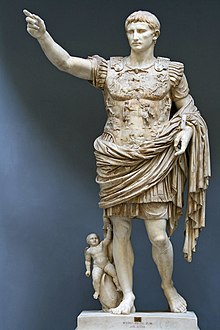Saylor.org's Ancient Civilizations of the World/Roman Art
Although the traditional interpretation of Roman art is that it largely borrowed/stole from Greek precedents, further study of Roman art has led many historians to see it as more creative and an adaptive pastische of Greek, Etruscan and even Egyptian visual motifs. Compared to the Greeks, with their very philosophical and theoretical views on art and aesthetics, the Romans were much more utilitarian and interested in art for decoration's sake and as a status symbol. Whereas ancient Greece revered their artists, most Roman artists remain anonymous, as most were artisans or other tradesmen working on commission. However, because the Romans were wealthier and more materialistic than the Greeks, an astonishing amount of their world was artistically decorated. In addition, because the Roman Empire was a much more cosmopolitan and integrating society than those of the provincial Greek city states, Roman art adapted and incorporated stylistic traits from other cultures with great ease.
Architecture
[edit | edit source]
Perhaps the greatest testament to the genius of the ancient Romans are their many architectural wonders such as aqueducts, temples, arenas and roads which still dot the European landscape almost 2000 years later. The ancient Romans were great adapters and innovators of architectural technique. Although they began with a base of architectural knowledge borrowed from the ancient Greeks, Romans used breakthrough techniques such as hydraulics, the arch, the dome and concrete to create edifices that still stand today. Some of the most notable Roman architectural wonders include the Flavian Amphitheater (the Roman Colosseum), the Pantheon, the Roman Forum, Hadrian's Wall, the Appian Way, the Aqueduct of Segovia, and the Circus Maximus.
The use of the arch, concrete and bricks was most vital to the construction of aqueducts, water conduits that brought clean water from distant sources into the cities for public baths, latrines and fountains, as well as for private households. The influx of clean water allowed Romans to develop proper sewage systems to free their cities of human waste. Aqueducts used the pull of gravity alone to move the water through a gradually downward moving conduit made of stone or concrete blocks. These waterways would run underground, circumvent large mountains and in the case of a valley, span across via large bridges supported by many arches.
Painting
[edit | edit source]
Most of what art historians know about Roman painting comes from pieces preserved in Pompeii and Herculanem, as they remained buried for nearly 1700 years following the volcanic eruption of Mount Vesuvius in 79 CE. Of these discoveries, the most important of these were the murals of Pompeii, many of which featured erotic imagery, considered by many to be outright pornographic. The ubiquity of sexual and fertility imagery, even on household items discovered serves as evidence that ancient Roman culture had much more relaxed views of sexuality than most modern societies. For many years after the discovery of these preserved murals, much more sexually conservative Europeans covered over much of these works with plaster or locked them away well until the end of the 20th century (and even some images are still inaccessible to minors). Apart from the sexual imagery, common subjects of paintings include animals, still life, scenes from everyday life, portraits, rustic countryside landscapes and some mythological subjects. Murals were meant to make the small, dark and cramped Roman buildings appear larger and brighter than they actually were. While the Romans had pioneered some use of the fresco technique, the majority of these painted murals was done in the secco style, on dry walls.
Sculpture
[edit | edit source]
Roman sculpture often fit into one of five categories: portraiture, historical relief, funerary reliefs, sarcophagi, and copies of ancient Greek works, particularly Greek bronzes. Much of what historians know about Greek art is owed to the Roman copies, which remained intact much better than their Greek inspirations.
In the case of portrait sculpture, historians have a difficult time trusting the reliability of the depictions particularly during the Imperial Era. As the sculptures often served as a form of propaganda for the Emperors, and the Emperors were deified, the depictions of individuals in the Imperial Era are usually physically idealized and glorified. History reliefs, as seen decorating Trajan's column and Roman triumphal arches was used by Emperors to glorify themselves and military victories. Trajan's column remains one of the finest examples of Roman relief sculpture, as the 650 foot column is decorated in a wrapping scroll of realistically carved individuals (over 2,500 of them), landscapes, animals, ships, and other elements to memorialize the victories of the Dacian Wars in modern day Romania.
Mosaics
[edit | edit source]
Romans enthusiastically took to the mosaic style of the Greeks. Romans would assemble small pieces of colored stones or glass in order to make a larger image, typically to adorn the large floors found in villas. Although some wall mosaics were included in Nero's Domus Aurea and in buildings found at Pompeii, large-scale wall mosaics would only become a major art form during the Christian era. A popular mosaic found on the thresholds of Roman villas was that of the image of a dog with the phrase Cave Canem, Latin for 'Beware of the Dog'.